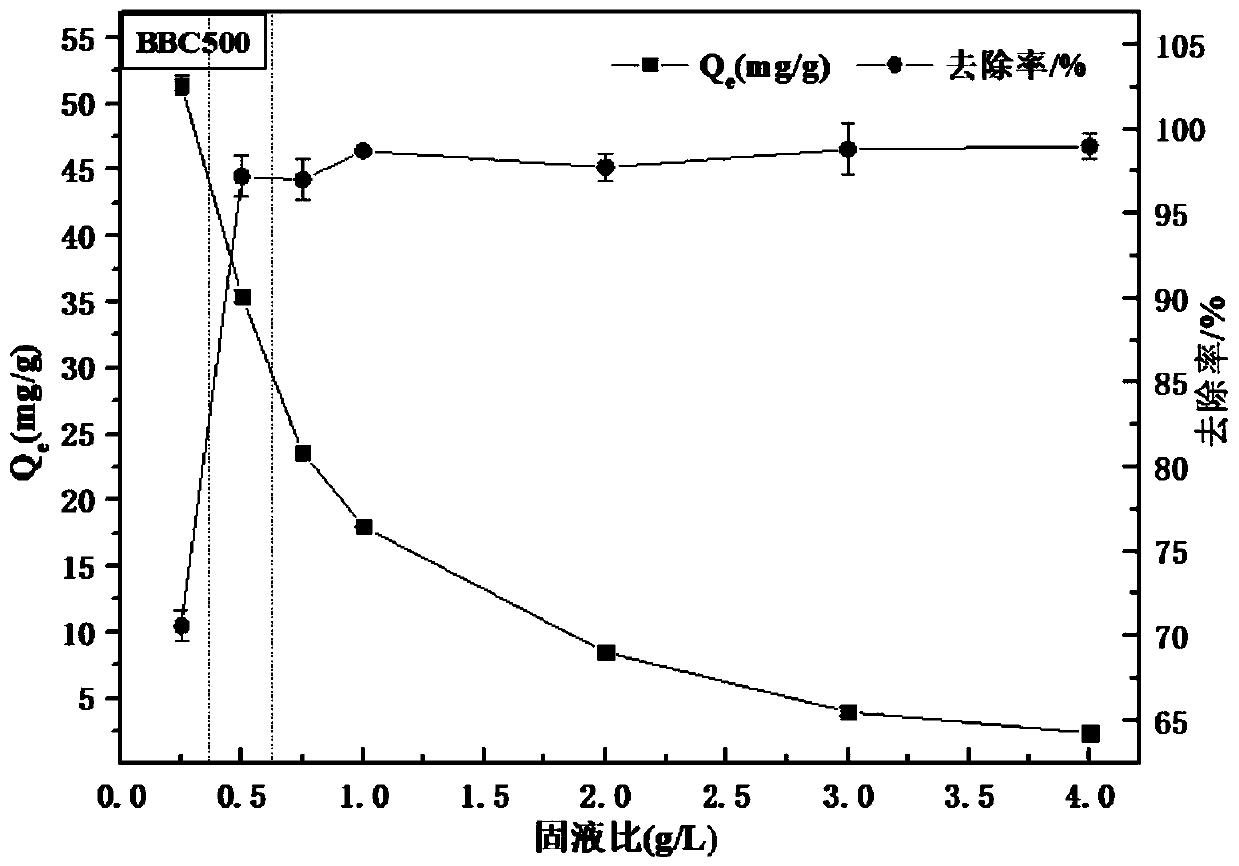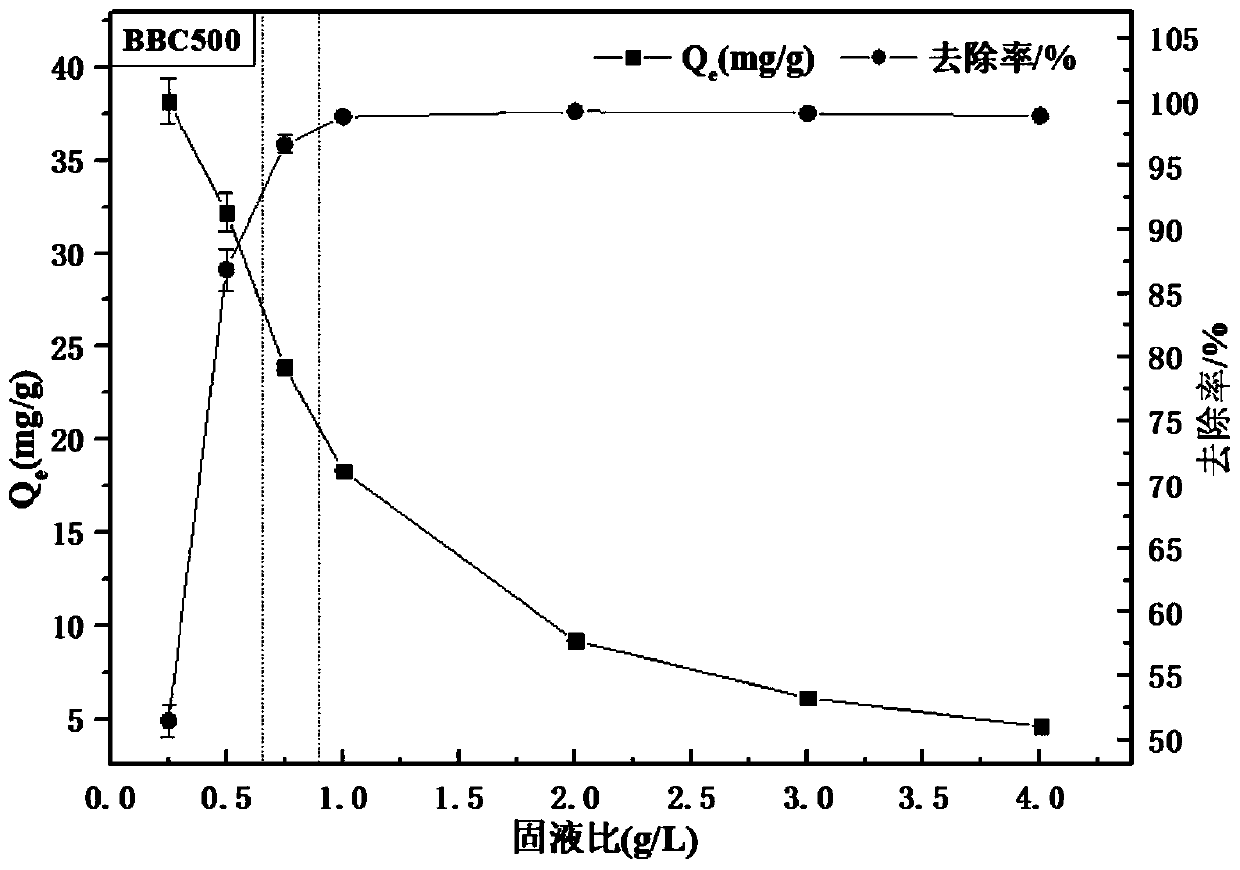Method for repairing Cd and Cu pollution by using biochar prepared from invasive plant bidens pilosa
A technology of ghost needle grass and invasive plants, which is applied in the field of preparing biochar to repair Cd and Cu polluted water bodies, can solve the problems of weak adsorption capacity, no heavy metal adsorption capacity, and limited effect of heavy metal treatment, achieving remarkable results, The effect of significant application value
- Summary
- Abstract
- Description
- Claims
- Application Information
AI Technical Summary
Problems solved by technology
Method used
Image
Examples
Embodiment 1
[0034] The preparation method of embodiment 1 invasive plant ghost needle grass bioactivated carbon
[0035] (1) Collection: collect the invasive plant P. trifoliate and air-dry it naturally for a week, then dry it in an oven at 80°C for 48 hours until dry, and use a universal grinder to crush and store it for later use;
[0036] (2) Preparation: Use the oxygen-limited temperature-rising carbonization method to weigh the pulverized product obtained in step (1), weigh 10.0 g of the pulverized product and put it into the muffle furnace, and inject nitrogen gas for 5 minutes to make the container in an oxygen-deficient state , burned under oxygen-limited conditions at 500°C, and started timing when it rose to the set temperature. After 3 hours of constant temperature pyrolysis, it was cooled to room temperature and taken out; the yield of biochar obtained under different carbonization conditions was calculated by the following formula. In the formula, Y is the yield of biochar (%...
Embodiment 2
[0040] Example 2 Solid-to-liquid ratio adsorption of Cd by biochar of the invasive plant Ghost needlewort 2+ 、Cu 2+ Impact
[0041] The embodiment of the present invention restores the polluted water bodies containing Cd and Cu respectively with different solid-to-liquid ratios, comprising the following steps:
[0042](1) Weigh 0.01, 0.02, 0.03, 0.04, 0.08, 0.12, 0.16g biochar samples in 50mL centrifuge tube, add 40 mL of Cd with an initial concentration of 20 mg / L 2+ solution. Shake at 150r / min for 24h in a constant temperature shaking box at 25°C, then pass through a 0.45μm microporous membrane, and measure the Cd in the supernatant with a flame atomic absorption spectrometer 2+ concentration;
[0043] (2) Weigh 0.01, 0.02, 0.03, 0.04, 0.08, 0.12, 0.16g biochar samples in 50mL centrifuge tube, add 40mL of Cu with an initial concentration of 20mg / L 2+ solution. Shake at 150r / min for 30h in a constant temperature shaking box at 25°C, then pass through a 0.45μm micropor...
Embodiment 3
[0046] Example 3 Effect of the initial pH of the solution on the adsorption of Cd by biochar of the invasive plant Ghost needlewort 2+ 、Cu 2+ Impact
[0047] The embodiment of the present invention repairs the polluted water containing Cd and Cu respectively with different initial pH of the solution, including the following steps:
[0048] (1) Weigh 0.02g of biochar into a 50mL round bottom centrifuge tube, add 40mL of Cd with a concentration of 20mg / L 2+ Solution, add a small amount of dilute HCl and NaOH solution dropwise to adjust the pH to 2, 3, 4, 5, 6, 7. Shake at 150r / min for 24h in a constant temperature shaking box at 25°C, then pass through a 0.45μm microporous membrane, and measure the Cd in the supernatant with a flame atomic absorption spectrometer 2+ concentration;
[0049] (2) Weigh 0.04g of biochar into a 50mL round bottom centrifuge tube, add 40mL of Cu with a concentration of 20mg / L 2+ Solution, add a small amount of dilute HCl and NaOH solution dropwise...
PUM
| Property | Measurement | Unit |
|---|---|---|
| adsorption capacity | aaaaa | aaaaa |
| adsorption capacity | aaaaa | aaaaa |
| adsorption capacity | aaaaa | aaaaa |
Abstract
Description
Claims
Application Information
 Login to View More
Login to View More - R&D
- Intellectual Property
- Life Sciences
- Materials
- Tech Scout
- Unparalleled Data Quality
- Higher Quality Content
- 60% Fewer Hallucinations
Browse by: Latest US Patents, China's latest patents, Technical Efficacy Thesaurus, Application Domain, Technology Topic, Popular Technical Reports.
© 2025 PatSnap. All rights reserved.Legal|Privacy policy|Modern Slavery Act Transparency Statement|Sitemap|About US| Contact US: help@patsnap.com



